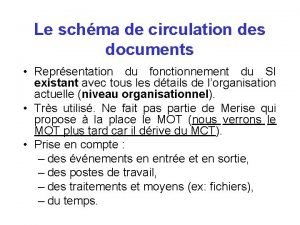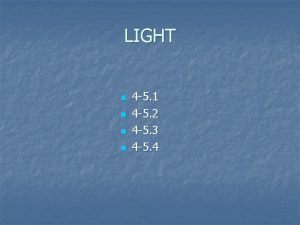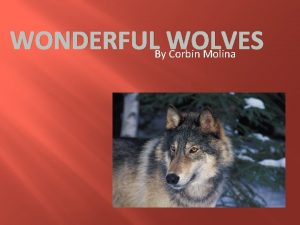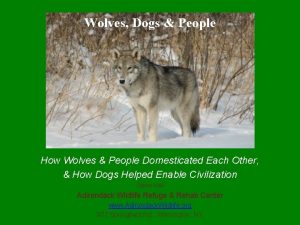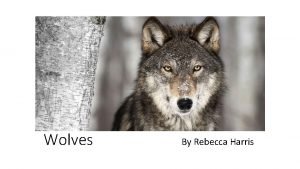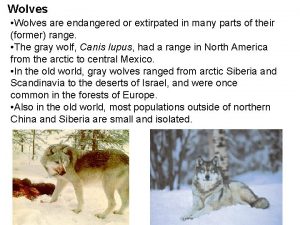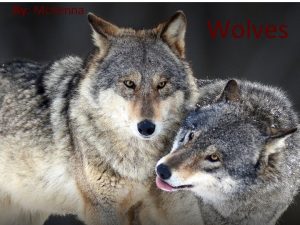Common materials with wolves Pictures with wolves Informations


















- Slides: 18

Common materials with wolves

Pictures with wolves

Informations about wolves Wolves are wild animals. They look very much like big domestic dogs. Usually wolves are grey with long fluffy tails, their hair is long and thick. Wolves are famous for their strong sharp teeth. They have long enduring legs and big paws. Wolves can live almost anywhere. They can be found in tundra, taiga, and steppe. There are even polar wolves. Wolves are predators and very smart hunters. Depending on the habitat they can feed on rodents, hoofed animals, and birds. In hungry winters wolves often attack livestock and even men. Wolves have great physical strength, endurance and agility. Moreover, they hunt in packs. That’s why their attacks are extremely successful. As wolves kill weak and sick animals first they are considered to be forest medics. But because of the danger they pose to people, many species of wolves have been completely wiped out, and many are considered endangered. A wolf is one of the favorite characters of folk tales. Its strength, intelligence and charisma are praised in them.

The gray wolves’ habitat In 2013, a genetic study found that the wolf population in Europe was divided along a north-south axis and formed five major clusters. Three clusters were identified occupying southern and central Europe in Italy, the Carpathians, and the Dinaric. Balkans. Another two clusters were identified occupying north-central Europe and the Ukrainian steppe. The Italian wolf consisted of an isolated population with low genetic diversity. Wolves from Croatia, Bulgaria, and Greece formed the Dinaric. Balkans cluster. Wolves from Finland, Latvia, Belarus, Poland Russia formed the north-central Europe cluster with wolves from the Carpathians cluster a mixture of wolves from the north-central cluster and the Dinaric-Balkans cluster. The wolves from the Carpathians were more similar to the wolves from the Ukrainian Steppe than they were to wolves from north-central Europe.

Life in the herd Wolf herd, called the gang may consist of several individuals. A pack of wolves living on Polish territory are small and have fewer than ten members. Power in the wolf herd fully strongest pair of adult wolves, called alpha pair. All members of the flock to find their place and role. With the eating of hunted animal, apply specific order approach to "table". The youngest wolves take care of all adult wolves in the herd. Overgrown puppies sometimes have to leave the herd, would not be a competition for the dominant pair. All the wolves living in the herd have their role to play. Some of them deals with the prediction of the danger of using the sense of smell. Others act as hunters off guard. Successive members of gangs kill hunted gains. The task of other wolves is to care for the offspring of the alpha pair.

Wolf communication – body language The wolf is one of the best communicators out there when it comes to the use of body language. The way that they walk as well as where they stand in comparison to the alpha male will tell you a great deal about where they fall in the social hierarchy of the pack. Scent markers are a way that they go about marking their territory. The area that a wolf pack covers can be up to 35 km 2 in some locations so they want to be sure other wolves don’t come around. Rolling around on the ground to rub their scent also is a great way to communicate with other members of their pack. It can be a way to invite them to take part in sharing space with them. It gives the message that they are approachable instead of on the defensive. In a wolf pack, being aware of the mood of the others in it is very important for individual survival.

Wolves in art works on glass

Wolves in art works on glass

Wolves in art works on glass

Wolves in art works using crayons

Wolf in art work using the computer

Wolves in art works using watercolors

Curiosities about wolves • Wolf pups are born blind, deaf and blue-eyed. Eye color changes to shades of yellow orange 8 to 16 weeks after birth. There are cases in which adults retain blue eyes. • Wolves can reach speeds of 65 km/h and run your fingers, not whole paw, which helps to stop quickly if needed. • Even trained wolves are not good "guards" because they have a natural fear of the unknown face and hide their visitors, instead of barking at them. • A wolf spends a third of his life moving. • Wolf fur consists of two layers - one surface rougher, which protects the animal from water and dirt and an inner, softer, which is renewed annually and is designed to isolate the body. Wolf fur mane lacks this lower layer.

Romanian mythology about wolves In the mountains of Transilvania wolves live in a large number, which gave rise to many legends about this wonderful animal. For more than 2000 years, Romanian people belived that wolves are magic animals. Dacians, the Romanians’ ancestors, belived in a wolf-god of light named Zalmoxis. Dacians initiated their warriors in the forests, where they had to live near wolves, dressed like a wolf, to acquire intelligence, courage, ability and fighting skills. The Dacian battle flg represented a wolf's head united with the body of a snake. Both of the animals symbolized the cyclicality of the universal existence, life and death, the beginning and end, the light and darkness, finite and infinite. In some Romanian areas, such as the Momârlan’s Land, people still belive and keep Dacian wolf flags. These people also belive that a boy or a man who is bitten by a wolf becomes a man-wolf, a wonderful and powerful creature which protects the village during the night. Some Romanian people think that during St. Andrew’s Day they must eat garlic to keep the wolves away from their animals. Although there are several legends and fairytales about wolves which ate people, there isn’t a specific case in which an adult or infant has been attacked or eaten by wolves. All Romanian people still consider the wolf an intelligent and loyal animal. The wolf is protected and respected. We call it `the doctor of the forest` because it keeps the forest clean by eating dead animals.

Links to wolf’s shows The wolf’s Romanian show https: //www. youtube. com/watch? v=EW-MI-AW 6 j. Y Wolves on glass painted by Turkish children https: //www. youtube. com/watch? v=Mc-Vk. K 7 Lk. Us Wolves on glass painted by Turkish children https: //www. youtube. com/watch? v=We 03 A 6 l 8 Bn 0

The Three Little Pigs Once upon a time, there were three little pigs. The pigs decided that they wanted to build themselves three houses. The first pig made a house out of hay. When a hungry wolf showed up, he started to blow the house away. The little pig ran away. It was so scared. He joined his brother’s house that it was made out of wood. The wolf started to blow so hard that the wooden house broke down. The two pigs ran faster than ever to save themselves from the hungry wolf. They got inside the house of the third pig, which was made of bricks. Finally, the pigs were safe. The wolf started blowing and blowing but could not damage the house. He got tired and left the place. The pigs were so happy that they survived and thanked the third pig for saving them. They all lived together happily. Story translated in English by Ιοanna Loukou, Greece

The wolf in the sheep costume There was a wolf who wanted to eat some sheep. The owner of the sheep did not care about that. He cared about his deer that the wolf wanted to eat too. One day the wolf found a costume of a sheep and wore it. He immediately went in and became one with the sheep. When night fell, the sheep owner put all the sheep in the barn. The wolf stayed alone with the sheep. However, the owner remembered that the next day would be a celebration and returned to the barn to take a sheep to roast. But as it was dark he grabbed a sheep, and that sheep was the wolf. So the wolf paid for his cruel intentions “Never judge anyone from his appearance” Story translated in English by Stavroula Goumenou, Greece

Wolf in the project’s gallery
 When a material is useful and harmful
When a material is useful and harmful Informations sur les chats
Informations sur les chats Représentation interne des informations
Représentation interne des informations Donner des informations personnelles
Donner des informations personnelles Informations
Informations Schma
Schma Columbia pictures and universal pictures
Columbia pictures and universal pictures Metro goldwyn mayer columbia pictures
Metro goldwyn mayer columbia pictures Construction materials names and pictures
Construction materials names and pictures How are hand tools classified?
How are hand tools classified? How to make simple electrical gadgets
How to make simple electrical gadgets Translucent objects images
Translucent objects images Cant stop the feeling go noodle
Cant stop the feeling go noodle Man made map
Man made map Adopting and adapting teaching materials
Adopting and adapting teaching materials Direct materials budget with multiple materials
Direct materials budget with multiple materials What are the things common to these pictures
What are the things common to these pictures Propaganda techniques images
Propaganda techniques images What do these pictures have in common
What do these pictures have in common





